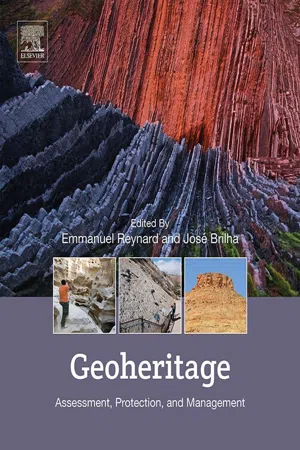
- 482 pages
- English
- ePUB (mobile friendly)
- Available on iOS & Android
About this book
For the last 20 years there has been a growing interest in the geosciences for topics related to geoheritage: geoconservation, geotourism and geoparks. Geoheritage: Assessment, Protection, and Management is the first and only reference book to cover these main topics as well as the relationship of geoheritage to other subjects such as landscapes, conservation, and tourism. The book also includes methodologies for assessment, mapping, and visualisation, along with case studies and colour images of some of the most important global geosites. This book is an essential resource for geoscientists, park and geopark managers, tourism and regional planning managers, as well as university students interested in geoheritage, geosites, geomorphosites, geoconservation, and geotourism. It also includes critical information on UNESCO's Global Geoparks, World Heritage and Biosphere Reserve sites, national parks and protected areas in general, land-use planning and nature conservation policies, and in the general contribution of geodiversity for sustainable development.- Winner of the 2019 AESE Award for Outstanding Publication- Written by a panel of 46 authors from 14 countries in all continents- Based on conceptual, methodological, and applied research carried out by academics and practitioners- Includes 160 colour images and maps of geoheritage sites- Features six case studies from sites in Africa, Asia, Australia, Europe, North America and South America
Frequently asked questions
- Essential is ideal for learners and professionals who enjoy exploring a wide range of subjects. Access the Essential Library with 800,000+ trusted titles and best-sellers across business, personal growth, and the humanities. Includes unlimited reading time and Standard Read Aloud voice.
- Complete: Perfect for advanced learners and researchers needing full, unrestricted access. Unlock 1.4M+ books across hundreds of subjects, including academic and specialized titles. The Complete Plan also includes advanced features like Premium Read Aloud and Research Assistant.
Please note we cannot support devices running on iOS 13 and Android 7 or earlier. Learn more about using the app.
Information
Geoheritage
Inventories and Evaluation
Abstract
Keywords
4.1 What Makes an Element of Geodiversity Exceptional?
| Value | Site/Location | Justification |
| Economic | Escondida Mine (Chile) | Chile is the top copper-producing country in the world. In 2015 this mine alone produced 1148 million metric tons comprising mostly copper concentrate, which generates important revenues for this country |
| Functional | Göreme National Park (Turkey) | The volcanic rocks of Cappadocia sculpted by erosion were used as dwellings, troglodyte villages and underground towns, which constitute the remains of a traditional human habitat dating back to the 4th century |
| Scientific | Basque Coast UNESCO Global Geopark (Spain) | The definition of two Global Boundary Stratotype Sections and Points (GSSPs, lower boundaries of the Selandian Stage and of the Thanetian Stage, both belonging to the Paleocene Series) turns the coastal cliffs of Zumaia into a place with global importance for geosciences |
| Educational | Terras de Cavaleiros UNESCO Global Geopark (Portugal) | The occurrence of a complete ophiolite sequence resulting from the obduction of Palaeothetys oceanic lithosphere over the Allochthonous Basal Complex attracts students from universities of different countries |
| Intrinsic | Volcanoes of Kamchatka (Russia) | Independently of human appreciation, this is one of the areas of higher density and diversity of active volcanoes on Earth |
| Cultural | Uluru-Kata Tjuta National Park (Australia) | The inselbergs of this park form an integral part of the traditional belief system of one of the oldest human societies in the world and it is considered a sacred place for the Anangu Aboriginal people |
| Aesthetic | Iguaçu National Park (Argentina/Brazil) | One of the world’s largest and most impressive waterfalls extending over some 2700 m, attracting about 1.5 million visitors each year to enjoy the natural beauty of the site |
| Uses of Geodiversity Elements | Users/Beneficiaries | Values |
| Scientific | • Geoscientists • Social scientists (archaeologists, ethnographers…) | Scientific |
| Cultural | ||
| Educational(formal and informal) | • Students and teachers of different domains are direct users of formal educational activities. • Informal educational actions are addressed to the general public. | Educational (geosciences, social and cultural sciences, etc.) |
| Cultural | ||
| Economic (indirectly) | ||
| Geotourism and recreation | • Nature tourism companies, guides, restaurant and hotel industries, handicraft companies, local cooperatives, rental bus and rent-a-car companies, etc. | Economic |
| Aesthetic | ||
| Cultural |
Table of contents
- Cover image
- Title page
- Table of Contents
- Copyright
- Photo Credit
- List of Contributors
- Biographies
- Acknowledgements
- Section I: Introduction
- Section II: Geodiversity
- Section III: Geoheritage
- Section IV: Geoheritage and Conservation
- Section V: Uses of Geoheritage
- Section VI: Case Studies
- Section VII: Conclusion
- Index
